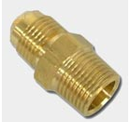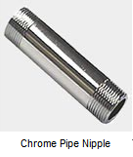Guide to Fitting Types & Materials
Plumbing is everything to do with pipes and their fittings. Pipes help to take/ supply water while fittings help control and manipulate the flow. Indeed, the pipes are pretty much straightforward to understand because they are straight and come in varying sizes. But the fittings are different.
Though plumbers find fittings pretty simplistic, they are complicated for most homeowners. For example, the materials, sizes, and names used on fittings can be quite confusing. Here is a guide to help you with fittings:
Types of Fitting
 Adapters
Adapters
Adapters are used for extending runs or changing the type of connection at the end of a pipe. This makes it possible for different types of pipes to be used without a complicated setup.
They are available in stainless steel, PVC, malleable, CPVC, Copper, brass, and ABS.
 Bushings
Bushings
This fitting is used for joining pipes with varying sizes. In most of the cases, bushings are used to reduce the flow of fluid or gas from a bigger pipe to a smaller one. In many cases, though not always, the bushes are threaded on the outside and inside. Besides, they also take up a very small space.
They are available in stainless steel, PVC, malleable, CPVC, Copper, brass, ABS, and chrome plated brass.
 Couplings
Couplings
This fitting is used for extending the run of a pipe. It can also be used to change sizes of pipes from a bigger to a smaller one. This is why they are at times referred to as reducers. They are sold with female threads or unthreaded in the case of plastic that can be glued. If the couplings are made of copper, they require soldering.
Couplings are offered in stainless steel, ABS, PVC, CPVC, copper, brass, malleable and chrome-plated brass.
 Elbow
Elbow
These fittings are designed for changing the direction of water flow. They are mainly produced in 45 and 90 degrees angles. They can also be sweated or threaded, and are considered among the most important components in plumbing. If you opt for the steel elbows, they are available in both female and male threaded ends. In some cases, the elbows can come with side outlet that makes it possible for them to act like a tee but with a bend.
 Nipples
Nipples
These are short stubs of pipes featuring threads on both ends. They are used to connect pipes runs and are especially considered useful for tight connections.
Nipples are available in brass, copper, chrome-plated brass, malleable, stainless steel, and PVC.
 Tees
Tees
If you need more than one branch of water supply, the fittings required for splitting is a tee. They are long couplings that feature a horizontal outlet (run) on one and another outlet at 90 degrees. If the run is smaller than the side outlet, it is called a “bull head”.
Tees are available in brass, ABS, copper, chrome-plated brass, CPVC, PVC, malleable and stainless steel.
 Crosses
Crosses
These are 4-way fittings that combine two tees. However, many people opt to utilize two tees instead of crosses.
Crosses in the market are available in PVC, malleable, and brass.
Common Fitting Materials
 ABS
ABS
ABS (abbrev for Acrylonitrile Butadiene Styrene) is a black plastic used in vents, drainage, waste, and sewer systems. They have become very popular and are considered a perfect replacement for steel, cast iron, and lead pipes that were previously common for drain-waste-vent (DWV). It’s interesting to note there is no primer (solvent cement) that can glue ABS effectively to PVC.
 Brass
Brass
This material is a mixture of metal, copper, and zinc. It could also have traces of tin, manganese, iron, and nickel. The brass fittings used for potable water are made with 65% copper, 35% zinc and very small percentages of tin and lead.
If you are dealing with hot water applications, it is advisable to go for brass works because it is resistant to heat and corrosion.

Copper
This is a reddish-brown and non-ferrous metal recommended for household plumbing pipes. Because it is soft and thin, threading is difficult. Therefore, many fittings made of copper are soldered.

CVPC (chlorinated polyvinyl chloride)
This is a plastic created for carrying drinking water at high temperatures than the standard PVC. It is also used for cold water delivery and industrial liquid handling.
 PVC
PVC
This is a rigid white type of plastic that is mainly applied for vent and wastewater systems. In other cases, it can also be used for cold underground water supplies outside the houses as well as venting, drains, and irrigation piping. PVC is mainly white though it can also be available in gray. In water conservation, you can also get purple PVC pipes used for differentiating grey water from drinking water.
If you want to have a properly functioning plumbing system, the first step is to understand the fittings. This post is a comprehensive guide to help you understand plumbing, fittings, and their design.
